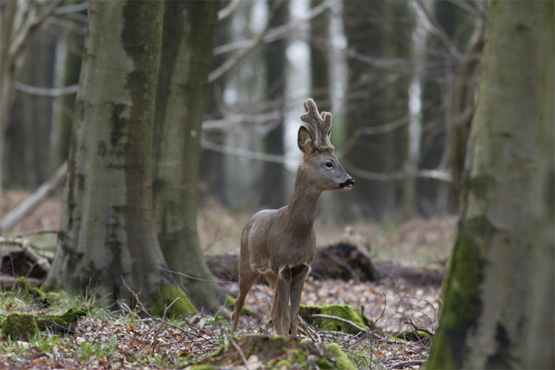We take a look at what you can expect from your deer stalking through the month of February.

(Above: Roe Buck in Velvet, Photograph courtesy of Ewan Dryburgh, we hope to see more of Ewans work in the months to come)
The unusually mild winter across the UK this year will, no doubt, have a positive effect on the number of young and old animals that will survive the winter months. There can be no more depressing sight than seeing magnificent red deer perishing on the Scottish hills, having been reduced to little more than skin and bone. Even in the south the mild conditions will, I hope, mitigate the sometimes inevitable spiral of decline that can be seen in the young fawns and kids after a hard winter.
I must ‘touch wood’ as I write this, not wishing to invite bad luck. A serious cold snap is still possible right through until the end of March. Indeed last year the weather continued unseasonably cold through until end of April. Of course it is too early to tell, and so I will write no more on the matter. Suffice to say that I keep my fingers and toes crossed.
So what does February bring? Well in Scotland with the season for Fallow Does, Sika and Red Hinds coming to a close on the 15th February, it will be Roe Does and Fallow Buck that will remain the only open quarry for a month or so. This allows the majority of Scottish stalkers, and indeed the Scottish deer themselves, a welcome respite from the chase.
In England & Wales the end of February used to mark the end of the doe/hind season, however today, with the change in legislation, the doe and hind season continues unabated until the end of March.
With most driven bird shooting coming to an end on 1st February many stalkers will be able to go about their business with less restriction from Game keepers, who, over the last few months, have kept tight control over any unnecessary intrusion over their grounds, intrusion that might be deemed to disturb their birds. For this reason, during February, a polite word will sometimes gain access to areas which otherwise might have been restricted.
Here at ‘County Deer Stalking’, as well as concentrating on the requirements of the doe cull, we will, like many others who have Roe deer on their grounds, be starting to take notes on the whereabouts and quality of our Roe Buck. Roe Buck in February now have antlers that are well advanced in velvet, and whilst it is difficult to be accurate about the size and quality of a fine head, it is, none the less, possible to gauge approximations as to the most promising animals. This feature will also allow us the luxury of foregoing such minute inspection of the rump in order to confirm gender.
The Roe will now of course be in large family groups, unlike the Fallow, who have retreated into their respective single sex herds. With the longer season attributed to Fallow Buck and the seasons continuance through until end of April, it will be the does of this species on which we will be focusing our attention.
Let us all hope that the mild winter continues albeit with a little less rain!
 IN Season in England & Wales: Roe Does, Fallow Does & Fallow Buck, Sika Stags & Sika Hinds, Red Stags & Red Hinds, CWD Bucks & CWD Does, Muntjac Buck & Muntjac Does.
IN Season in England & Wales: Roe Does, Fallow Does & Fallow Buck, Sika Stags & Sika Hinds, Red Stags & Red Hinds, CWD Bucks & CWD Does, Muntjac Buck & Muntjac Does.
Off Season in England & Wales: Roe Buck.
In Season in Scotland: Sika Hinds, Red Hinds and Fallow Does until 15th Feb only. Fallow Buck & Roe Does remain in season throughout February.
Off Season in Scotland: Red Stags, Sika Stags & Roe Buck. Also Red & Sika Hinds and Fallow Does from 16th February.
Peter Jones - Editor



















